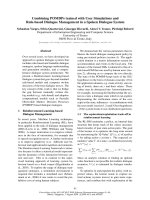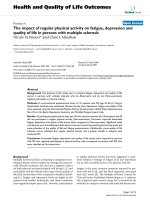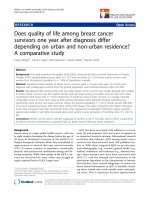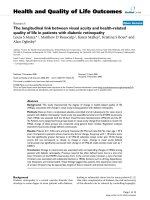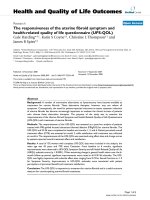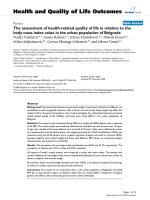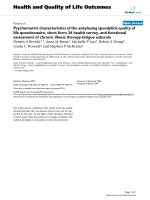báo cáo hóa học:" Osteoarthritis: quality of life, comorbidities, medication and health service utilization assessed in a large sample of primary care patients" potx
Bạn đang xem bản rút gọn của tài liệu. Xem và tải ngay bản đầy đủ của tài liệu tại đây (291.58 KB, 9 trang )
BioMed Central
Page 1 of 9
(page number not for citation purposes)
Journal of Orthopaedic Surgery and
Research
Open Access
Research article
Osteoarthritis: quality of life, comorbidities, medication and health
service utilization assessed in a large sample of primary care
patients
Thomas Rosemann*, Gunter Laux and Joachim Szecsenyi
Address: Department of General Practice and Health Services Research, University of Heidelberg, Voßstrasse 2, 69115 Heidelberg, Germany
Email: Thomas Rosemann* - ; Gunter Laux - ;
Joachim Szecsenyi -
* Corresponding author
Abstract
Objective: To assess the gender related impact of osteoarthritis (OA) on quality of life (QoL) and
health service utilization (HSU) of primary care patients in Germany.
Methods: Cross sectional study with 1250 OA patients attending 75 primary care practices from
March to May 2005. QoL was assessed using the GERMAN-AIMS2-SF. Data about comorbidities,
prescriptions, health service utilization, and physical activity were obtained by questioning patients
or from the patients' medical files. Depression was assessed by means of the Patient Health
Questionnaire (PHQ-9).
Results: 1021 (81.7%) questionnaires were returned. 347 (34%) patients were male. Impact of OA
on QoL was different between gender: women achieved significantly higher scores in the AIMS 2-
SF dimensions lower body (p < 0.01), symptom (p < 0.01), affect (p < 0.01) and work (p < 0.05).
Main predictors of pain and disability were a high score in the "upper body "scale of the AIMS2-SF
(beta = 0.280; p < 0.001), a high score in the PHQ-9 (beta = 0.214; p < 0.001), duration of OA (beta
= 0.097; p = 0.004), age (beta = 0.090; p = 0.023) and the BMI (beta = 0.069; p = 0.034). Predictors
of pain and disability did not differ between gender. 18.8 % of men and 19.7% of women had a
concomitant depression. However, no gender differences occurred. Women visited their GP
(mean 5.61 contacts in 6 months) more often than men (mean 4.08; p < 0.01); visits to orthopedics
did not differ between gender.
Conclusion: The extent to which OA impacts men and women differs in primary care patients.
This might have resulted in the revealed differences in the pharmacological treatment and the HSU.
Further research is needed to confirm our findings and to assess causality.
Background
Osteoarthritis is one of the most prevalent chronic dis-
eases worldwide and is associated with substantial impact
on patients' individual quality of life as well as on health-
care costs. Its prevalence is expected to rise significantly in
the upcoming decades. Increasing life expectancy and
decreasing physical activity, leading to a constant increase
in body weight, are regarded as underlying determinants
of this development. Facing this situation, the WHO and
the United Nations have declared the years 2000 to 2010
Published: 30 June 2007
Journal of Orthopaedic Surgery and Research 2007, 2:12 doi:10.1186/1749-799X-2-12
Received: 7 October 2006
Accepted: 30 June 2007
This article is available from: />© 2007 Rosemann et al; licensee BioMed Central Ltd.
This is an Open Access article distributed under the terms of the Creative Commons Attribution License ( />),
which permits unrestricted use, distribution, and reproduction in any medium, provided the original work is properly cited.
Journal of Orthopaedic Surgery and Research 2007, 2:12 />Page 2 of 9
(page number not for citation purposes)
to be the "Bone and Joint Decade" [1]. Since in the year
2050 more than 50% of the population will be over 50
years of age, the German health care system will be hit tre-
mendously by chronic illnesses like osteoarthritis [2].
Most of these individuals will receive medical treatment
in primary care settings, accounting for the growing
number of studies dealing with OA in primary care [3-5].
However, to date, relatively little is known about osteoar-
thritis symptoms and their medical treatment in various
subgroups of patients in primary care.
Previous studies have focused on the prevalence and prog-
nosis of OA [4,6]. Regarding prevalence, it is a frequently
replicated result that women have a higher probability for
developing OA, especially OA of the knee [7,8]. Several
studies have suggested that not only prevalence but also
the disease process is related to gender: women were
found to have more severe structural progression and a
higher need to undergo surgical interventions than men
[6]. Other studies suggested that women with OA suffer
from pain and disability to a greater extent compared to
men and also that these dimensions of QoL are strongly
associated with the social situation [9-11]. However, it
remains unclear how these findings can be explained.
The present study was performed to get a comprehensive
overview of the health status and the healthcare received
by primary care patients with OA in Germany. We partic-
ularly focused on differences related to gender because we
hypothesized that men and women differ regarding
health status and health service utilization (HSU). Fur-
thermore, since it is known that quality of life (QoL) of
OA patients is mainly determined by pain and disability
our aim was to assess factors that are associated with these
two dimensions of QoL [8,12].
Materials and methods
The data used for this study are retrieved from the baseline
assessment of the PraxArt project, which is financed by the
German Ministry for Education and Research over a
period of 6 years, starting in 2003. The aim is to assess the
status of OA care and to search for possibilities to improve
care as well as patients' quality of life by tailored interven-
tions. A randomly created sample of 75 general practition-
ers in the area of Baden-Wuerttemberg and Bavaria has
been enrolled and recruited the patients for this survey.
Participants
To be eligible for inclusion, patients had to be adult and
diagnosed with osteoarthritis of the hip or knee according
to the Committee of the American Rheumatism Associa-
tion[13,14]. In each of the participating 75 practices, 15
patients fulfilling these criteria were addressed consecu-
tively. In total, 1250 questionnaires were administered to
patients after they had given their written informed con-
sent. They were asked to return the questionnaires to the
university by sending a stamped envelope and were
informed that neither the GP nor the practice team had
any possibility to get knowledge of their answers. GPs cre-
ated a list of all addressed patients. Since the patients were
addressed by their GP, detailed information about socio-
demographic data, comorbidities, and medication were
also available for the non-respondents.
Data collection
Sociodemographic data included gender, age, educational
level (1 = no school degree to 5 = university degree), work-
ing situation (1 = unemployed or retired, 2 = half time, 3
= fulltime), and partnership (1 = living alone, 2 = mar-
ried/living with partner). As in the long version of the
AIMS2, some important comorbidities were assessed in
the questionnaire: high blood pressure (HBP), diabetes,
heart insufficiency (HI), coronary vessel disease (CVD),
elevated cholesterol level (low density lipoprotein (LDL)
> 200 mg/dl), ulcer or stomach disease, asthma/chronic
obstructive pulmonary disease (COPD), kidney disease,
cancer and stroke. Patient's answers were compared with
comorbidities mentioned in the medical file via the list
the GPs had created when addressing patients. This was
done to increase validity of data and also to assess accu-
racy of self reported diagnosis later on in the project. The
same procedure was performed for all other answers,
including disease duration. For the analysis in this study
the date form the medical files were used. Disease dura-
tion was defined as the period form mentioning OA for
the first time in the medical file till now. Depressive disor-
der was diagnosed using the depression module of the
German form of the Patient Health Questionnaire (PHQ-
9) [15]. The PHQ-9 is a self-administered questionnaire
that enables to diagnose a Major or Minor Depression Epi-
sode according to DSM-IV [16,17]. Moreover, the summa-
rized scale score allows assessing the severity of
depression. The PHQ-9 has proven to be a valid instru-
ment for these assessments [18,19].
The impact of OA on patients' health was assessed by the
GERMAN-AIMS2-SF, which provides a comprehensive
assessment of patients' health status comprising the
dimensions physical limitation, symptom (reflecting per-
ceived pain), social (reflecting social contacts), affect
(reflecting mood), and work (reflecting the ability to
work). It has recently been validated in German language
in a sample of OA patients [20]. As suggested in this study,
we divided the physical limitation scale of the AIMS2-SF
into upper body limitation and lower body limitation. To
get a comprehensive view of the present situation of OA
patients, we collected all information about medication
and HSU from the patients' files. Since not all information
on medication (e.g. OTC medication), HSU (e.g. visits to
healers) and treatments (e.g. acupuncture) were available
Journal of Orthopaedic Surgery and Research 2007, 2:12 />Page 3 of 9
(page number not for citation purposes)
in the files, we assessed data about these parameters by
straightforward questions. As described above, to com-
plete data, each questionnaire was compared with the
medical file to which it was linked by an identification
number on the participants list. So, data given by patients
could be checked by comparing them with the medical
file. Non-respondents were identified by comparing GPs
lists of addressed patients with received questionnaires.
Patients were asked to mention all disease specific medi-
cations they take additionally to prescriptions, including
OTC medication, homeopathic medication and sympto-
matic slow-acting drugs in osteoarthritis (SYSADOA).
SYSADOA is a generic term and covers a wide range of
substances. In Germany some of them have to be pre-
scribed, others are regarded as health food supplement, as
it is the case for instance in the United Kingdom. We
assessed separately whether SYSADOAs were prescribed or
whether patients bought them without prescription.
Regarding Health Service Utilization (HSU), patients were
asked about all contacts to orthopedic surgeons, healers,
received x-rays, physiotherapy, acupuncture and intraar-
ticular injections. The International Physical Activity
Questionnaire (IPAQ), a widespread assessment instru-
ment was used to assess physical activity [21]. Inclusion of
patients did not start unless there was a written and unre-
stricted positive vote of the ethics committee of the Uni-
versity of Heidelberg which was received in March 2005
(approval number 021/2005).
Statistical analysis
The data were analyzed with SPSS (version 12.0). Descrip-
tive analyses were performed for all variables. Continuous
variables are reported using means, standard deviations
(SD), ranges and percentages. Unadjusted group compar-
isons were performed by means of Student's t-test. Nor-
mality was tested by means of Kolmogorov-Smirnov-test
to allow parametric test were applicable. For the compar-
ison of medication, comorbidities and depression catego-
ries, which represented binary variables, the Chi-square-
test was used. Since the prevalence of depression differs
between men and women, the analysis was performed
separately for gender[22]. Comparisons of depression
prevalence (PHQ-scores), and HSU were made by ANCO-
VAs adjusted for covariates that may have substantial
influence such as age, disease duration, comorbidities and
QoL (AIMS2-SF scales assessing pain, physical limitation
and social). Pain and disability are known to be the most
important factors determining QoL in OA patients. To
assess predictors of these two factors, we calculated a sum
score of the AIMS "symptom" and "lower body" dimen-
sion and calculated univariate correlations to sociodemo-
graphics and disease characteristics (by means of
Spearman's rho). Factors with significant correlations
were included in a stepwise regression analysis (method:
enter) to reveal significant predictors.
Results
In total, 1311 patients were addressed by the GPs. 1250 of
them agreed to complete the questionnaire. 1021 of the
1250 (81.7%) patients returned the questionnaires, corre-
sponding to at least 11 questionnaires in each practice.
Regarding available data, including sociodemographic
variables, comorbidities and medication, no statistically
significant differences could be revealed between the non-
respondents and the respondents. The main reason given
for not participating was time effort. Among the enrolled
patients, 347 (34.0%) were male and 674 (66.0%) were
female. If missing data occurred, they mainly occurred
within the same questionnaire, in total in 271 of the 1021
questionnaires. In 123 cases the data could be completed
from the patient file.
278 (80.1%) men were married or lived with a partner.
376 (55.8%) women were engaged. This difference was
significant (p < 0.01). Completely retired from work were
233 (67.1%) men and 482 (71.5%) women. T-test for
group comparison revealed a significant difference in the
(formal) educational level between men (mean 2.61, SD
1.1) and women (mean 2.38, SD 0.83). BMI, age, number
of comorbidities or disease duration did not differ signif-
icantly. Table 1 displays the characteristics of the study
sample separated by localization of OA.
Quality of Life
Regarding the impact of the disease on QoL, women
achieved significantly higher scores in the lower body
scale (2.98 vs. 2.39; p < 0.01), indicating more physical
disability. Also the scores in the affect scale (3.10 vs. 2.60;
p < 0.01) and the symptom scale (5.12 vs. 4.49; p < 0.01)
indicated that women had significantly lower mood and
significantly more perceived pain than men (Table 1).
This result remained significant even if the ANCOVAs
were adjusted for age, disease duration and comorbidities.
Due to the inclusion criteria, focusing on patients with OA
to the lower limb, the scores for the upper body limitation
were low, indicating no functional disability and did not
differ by gender. Differences in the work scale were nota-
ble (p < 0.05), but because of the large number of retired
patients the absolute numbers were small.
Comorbidities
Table 2 displays the distribution of comorbidities sepa-
rated by gender. As can be seen, high blood pressure and
elevated cholesterol were the most common comorbid
conditions. Significant gender differences occurred only
regarding HBP (p < 0.01). Asked about side effects related
to their osteoarthritis medication, 282 (81.27%) men and
563 (83.53) women agreed to have had side effects during
Journal of Orthopaedic Surgery and Research 2007, 2:12 />Page 4 of 9
(page number not for citation purposes)
the last 6 months. Interestingly, 77 men (22.19 %) and
146 women (21.66%) reported having ulcer or stomach
pain in their history.
Depression as comorbidity
In summary, 344 (99.1%) men and 668 (99.1%) women
completely answered all 9 items of the PHQ-9 (table 3).
Among these, 38 (11.0%) men fulfilled criteria for a
major depressive episode and 27 (7.8 %) fulfilled criteria
for a minor depressive episode. In women, 84 (12.6 %)
had a Major Depression episode and 47 (7.1 %) a Minor
Depression episode. The overall prevalence of depressive
disorders was 19.4%. ANCOVA adjusted for age, disease
duration and comorbidities revealed no significant differ-
ences in PHQ-9 scores as well as in the occurrence of
minor and major depression between men and women.
Additionally, a Chi-square test was performed to compare
the severity categories as binary data (no depression,
minor, major). This test also revealed no gender differ-
ence.
Health Service Utilization
Table 4 displays the health service utilization of the study
sample within the last 6 months before the assessment.
86.4% of women and 76.7% of men visited their GP at
least once during the last half year. The amount of visits to
the GP varied widely from 0 to 12 during half a year with
a mean of 5.61 (SD 8.26) in women and 4.08 (SD 6.29)
in men, representing a significant difference (p = 0.001) in
ANCOVAS adjusted for age, disease duration and comor-
bidities. Regarding visits to orthopedic surgeons, with a
mean of 1.88, women had slightly more contacts than
men (mean 1.68), but the difference remained not statis-
tically significant after adjusting for covariates as men-
tioned above. More than a quarter of the patients received
some acupuncture during the last half year and nearly a
quarter visited a traditional healer at least once. ANCO-
VAs revealed that men received significantly more often
injections in the joint (p = 0.026), but less acupuncture (p
= 0.042). Regarding physiotherapy, performed x-rays, and
visits to healers, no significant differences between gender
could be revealed by means of ANCOVAs.
Table 2: Comorbidities of the study sample (n = 1021) separated by gender
gender High blood
pressure**
Elevated
cholesterol
Diabetes Heart
Insufficiency
Coronary
vessel
disease
Ulcer/
Gastritis
Asthma/
COPD
Renal
Insufficiency
Cancer Stroke
male 181 124 57 63 62 77 34 23 21 16
% 52.1 35.7 16.4 18.1 17.8 22.1 9.8 6.6 6.1 4.6
female 384 245 120 131 70 146 64 33 16 30
% 56.9 36.3 17.8 19.4 10.3 21.6 9.5 4.9 2.4 4.4
Total % 55.2 36.1 17.3 19.0 12.9 21.8 9.6 5.5 3.6 4.5
* p < 0.05; ** p < 0.01 in Chi-square test
Table 1: Characteristics of enrolled patients (n = 1021) separated by localization of OA
total Hip Knee
Men Women Men Women
Number of participants 1021 191 236 156 438
Mean (SD) age (y) 66.1 (15.1) 64.3 (14.8) 65.3 (14.5) 66.5 (15.4) 67.1 (15.4)
Disease duration (years) 13.7 (13.0) 11.7 (10.8) 12.3 (12.1) 14.1 (12.9) 15.2 (14.2)
Body mass index (kg/m
2
) 28.3 (4.7) 27.4 (3.7) 27.1 (4.5) 28.6 (3.4) 29.2 (4.8)
AIMS2-SF dimensions:
Lower body ** 2.64 (2.04) 2.19 (1.97) 2.22 (2.25) 2.81 (2.71) 3.01 (2.95)
Upper body 1.21 (2.02) 1.02 (1.86) 1.19 (1.17) 1.09 (1.77) 1.34 (2.32)
Symptom ** 4.71 (2.42) 4.21 (2.13) 4.37 (2.19) 4.68 (2.83) 5.12 (2.91)
Affect ** 2.77 (1.51) 2.39 (1.42) 2.81 (1.48) 2.52 (1.50) 3.01 (1.59)
Social 4.57 (1.95) 4.26 (1.88) 4.44 (1.72) 4.45 (1.90) 4.82 (2.03)
PHQ-9 sum score 15.7 (4.69) 14.9 (4.33) 15.9 (4.86) 15.4 (5.02) 16.1 (5.32)
Unilateral OA (%) 150 (13.8) 32 (16.7) 41 (17.3) 32 (20.5) 45 (10.2)
Number (%) with bilateral OA 871 (84.5) 159 (83.2) 195 (82.6) 124 (79.5) 393 (89.7)
Number (%) with generalized OA
¶
282 (25.4) 26 (13.6) 57 (24.1) 33 (21.1) 166 (37.8)
Journal of Orthopaedic Surgery and Research 2007, 2:12 />Page 5 of 9
(page number not for citation purposes)
Pharmacological treatment
NSAIDs represented the most frequently prescribed med-
ication in our study sample. Women received NSAIDs sig-
nificantly more often (p = 0.043) than men, while the
gender differences in the less often prescribed COX-2-
inhibitors were not significant (Table 5). Paracetamol was
assessed because it is recommended as treatment of first
choice in most guidelines. Interestingly, Paracetamol was
used only marginally. About 5% of patients of each gen-
der were treated with opiates, women received signifi-
cantly more opiates that belonged to step III according to
the WHO step scheme of pain treatment. Overall, SYSA-
DOAs were only marginally prescribed, they were mostly
taken as OTC medication. Regarding homeopathic medi-
cation, no significant difference could be observed
between gender.
Table 6 displays univariate correlations between the sum
score of the "symptom" and the "lower body" scale of the
AIMS2-SF reflecting the main impact of arthritis on QoL,
pain and disability. Factors which achieved significance
were entered into the regression model. As can be seen in
table 7, the main predictors of "pain and disability" are a
high score in the "upper body "scale of the AIMS2-SF
(beta = 0.280; p < 0.001), a high score in the PHQ-9 (beta
= 0.214; p < 0.001), duration of OA, age and the BMI. The
whole model explained over 40% of variation in the
dependent variable. In a first approach the analyses was
made separately for both gender. Interestingly, predictors
were the same for both gender, differences occurred only
with respect to the amount of the regression coefficient
beta. Consequently, the results were displayed for both
gender together.
Discussion
Based on previous findings indicating biological differ-
ences (e.g. regarding the destruction of the cartilage) and
psychological differences (e.g. perception of pain) we
hypothesized that men and women differ regarding many
aspects of QoL and received care. This hypothesis could be
confirmed: OA has higher impact on women in important
aspects of QoL such as pain, disability and mood. Similar
gender differences have been found e.g. by Woo et al.
among Chinese people [23]. They received more NSAIDs
and visited their GP but not their specialist more fre-
quently than men and tended to have less intraarticular
injections. Interestingly, minor or major depressive epi-
sodes were not more frequent among women, even
Table 4: Health service utilization of the study sample within 6 months
During the last 6 months Gender At least one (%) Mean SD
GP visits ** Male 76.7 4.08 6.29
Female 86.4 5.61 8.26
Visits to Orthopedic surgeon Male 56.8 1.68 3.17
Female 58.8 1.88 3.77
Physiotherapy* Male 51.3 5.66 11.52
Female 60.5 7.26 12.08
X-rays of joint Male 49.1 0.78 3.82
Female 52.5 0.98 4.15
Intraarticular injections** Male 34.3 1.20 4.38
Female 30.6 0.89 4.08
Acupuncture* Male 26.8 0.68 2.69
Female 27.9 1.22 4.53
Visits to Healers Male 22.5 0.21 1.31
Female 23.5 0.33 3.21
* p < 0.05, ** p < 0.01 in adjusted ANCOVA (age, disease duration, comorbidities)
Table 3: Scores of the severity index of depression (PHQ-9 questionnaire)
PHQ-9 scores Fulfilling criteria for Overall
Gender N Mean SD Major Depression Minor Depression Depressive Disorder
male 344 15.33 4.76 38 (11.0%) 27 (7.8 %) 65 (18.9%)
female 668 15.95 4.63 84 (12.6 %) 47 (7.1 %) 131 (19.6%)
∑ 122 (12.0%) 74 (7.3%) 196 (19.4%)
* p < 0.05; **p < 0.01; PHQ-9 scores compared by ANCOVA (adjusted for age, disease duration and comorbidities); severity categories by means
of Chi-square-test
Journal of Orthopaedic Surgery and Research 2007, 2:12 />Page 6 of 9
(page number not for citation purposes)
though the affect scale of the AIMS2-SF indicated lower
mood among women.
Regarding QoL, we found lower scores than Sany et al. did
in a sample of rheumatoid patients regarding physical
limitation. However, we observed nearly the same mean
scores regarding the symptom scale. This finding may
indicate that patients suffering from OA are less limited in
their mobility but appear to suffer from equivalent pain
intensity than patients with rheumatoid arthritis (RA).
With regard to comorbidities which have an important
impact on the QoL of patients suffering from osteoarthri-
tis as well as on the outcome of surgical interventions,
gender differences occurred only regarding high blood
pressure [24-27]. Unfortunately, reliable data regarding
comorbidities in OA patients are difficult to compare
since different comorbid conditions have been assessed
with different methods (e.g. self reports) in previous stud-
ies. Groessl et al. who enrolled 363 OA patients in a pri-
mary care setting in a health management organization
(HMO) in the United States reported on somewhat lower
rates of HBP (28.8 %), which was the commonest comor-
bidity in their sample. Similar numbers were found by
Nilsdotter et al. [26]. Compared to national data, the
prevalence of HBP in Germany in this age group is
expected to be over 55%, as was found in a large interna-
tional comparison [28]. However, a limitation of our
findings is that no control group was available.
Regarding pain medication, Paracetamol, which is the
first choice treatment according to most guidelines, was
only marginally prescribed. The main pillar in pharmaco-
logical treatment are NSAIDs such as Diclofenac [29-31].
This is in accordance with the fact that NSAIDs are known
to be increasingly used worldwide [32]. Interestingly,
COX-2-inhibitors played no important role in prescrip-
tions. Our data also confirmed previous findings showing
that the use of NSAIDs is more frequent among women
than men [33]. In the study of Linsell et al. 45.9% of OA
patients stated to take pain killers frequently, which is
comparable to our results[3].
Regarding HSU, our data indicated a high HSU by OA
patients. However, it has to be noted that the German
health care system is characterized by a high physician
contact-rate. The number of mean contacts per year and
person in Germany, including all contacts to GPs and spe-
cialists, is 6.6 [34]. In Germany patients have free access to
secondary care, a referral is not required [35]. Thus, the
revealed high amount of x-rays for example may also be
due to the unlimited accessibility of health care in Ger-
many [36]. The reason why women visited their GP more
often than men could be related to the higher pain scores
of women, since it is known that pain is a strong predictor
Table 6: Correlations between sociodemographic and disease
characteristics with "pain and disability"
Spearman's' rho p
Sociodemographics
Age 0.052 0.129
Marital status -0.069 0.028
Gender 0.096 0.002
Education -0.076 0.016
IPAQ sum score -0.033 0.346
BMI 0.157 <0.001
Health service utilization
GP contacts 0.251 <0.001
Visits to Orthopedics 0.238 <0.001
Visits to healers 0.007 0.831
Amount of performed X-rays 0.254 <0.001
Physiotherapy 0.207 <0.001
Amount of prescriptions 0.178 <0.001
Disease characteristics
Duration of OA 0.269 <0.001
Amount of comorbidities 0.221 <0.001
PHQ-9 sum score 0.475 <0.001
Quality of life/AIMS2-Sf scales
Upper body 0.398 0.001
Affect 0.472 0.001
Social 0.212 <0.001
Work -0.018 0.569
Table 5: Medication of the study sample (n = 1021) separated by gender
Pain relievers Homeopathics SYSADOA
(OTC)**
SYSADOA
(prescription)
Muscle
relaxant
NSAID Opiats others Paracetamol
Unselective
COX-inhibitors*
COX-2 WHO II WHO III
Male (347) 120 (34.6%) 8 (2.3%) 18 (5.2%) 4 (%1.15)* 7 (2.0%) 2 (0.6%) 20 (2.0%) 34 (9.8%) 9 (2.6%) 8 (2.3%)
Female (674) 276 (40.1%) 18 (2.7%) 32 (4.8%) 14 (2.0%)* 14 (2.0%)* 8 (1.2%)* 49 (2.5%) 78 (11.6%) 18 (2.7%) 14 (2.1%)
∑ 38.7% 2.6% 4.9% 1.8% 2.1% 1.0% 6.8% 10.7% 2.64 2.2
* p < 0.05; **p < 0.01 in Chi-square-test
Journal of Orthopaedic Surgery and Research 2007, 2:12 />Page 7 of 9
(page number not for citation purposes)
for HSU among OA patients [27]. Interestingly, gender
differences could only be revealed regarding contacts to
GPs but not to specialists. An important weakness of the
presented data is that, even though the analyses were
adjusted for important covariates, HSU may have been
related to other reasons except arthritis, even though we
asked patients to mention only contacts which were
related to OA. It should also be mentioned that we did not
control our data for patients' insurance. About 10% of
patients are "privately" insured, resulting in higher reim-
bursement for physicians. This may have influence on
treatments, prescriptions as well as on referral rates. Our
data regarding HSU reflect a finding that may be ignored
by many physicians: the important role of complemen-
tary alternative medicine (CAM) for patients with OA. As
Rao et al. could show the use of CAM is very common
among patients with RA. Our data regarding visits to heal-
ers and received acupuncture are lower in comparison to
the findings of Rao, who reported a frequent use of up to
90% among the RA patients, but at least more than a quar-
ter of our patients reported on current use of CAM [37].
According to Rao, only half of the patients discuss the use
of CAM with their physician, so they should be aware of
this issue and address it in order to avoid treatment con-
flicts or side effects. Interestingly, comparable findings
regarding CAM have been reported by Linsell et al. in a
sample of OA patients in the UK [3]. Many studies have
assessed depression in patients with rheumatoid arthritis,
some of which indicate a higher risk among patients with
RA than OA patients [38,39]. None of them enrolled as
much OA patients as we did. The importance of depres-
sion for OA patients is related to the fact that it is an
important predictor for functional disability and an inde-
pendent risk factor for mortality in RA [40]. Previous find-
ings regarding the prevalence among OA patients
indicated no increased prevalence [41,42]. Our data
showed that 19.7% of women and 18.9% of men fulfilled
the criteria for a major or minor depressive episode. Data
regarding the point prevalence among the German popu-
lation vary between 5–10 % in the general population
[19]. In contrast to the general population, no gender dif-
ferences could be revealed in our study sample. Our find-
ings indicate a significant increase in the point prevalence
but the numbers of about 30% reported for RA patients
were not met [43].
Pain and disability have often been shown as the major
burden of OA. Similar as in various other studies, women
achieved higher scores regarding both symptoms of OA
[23]. But interestingly, no gender differences could be
revealed regarding their predictors.
Despite the fact that our study has certain limitations and
acknowledging the characteristics of the German health
care system with e.g. a large number of non-surgical
orthopedics, the study gives a comprehensive overview.
However, because of the wide range of aspects addressed
in this paper, it is not possible to describe the findings in
detail e.g. in the sense of revealing predictors for each var-
iable. The study represents the largest assessment of OA
patients in a primary care setting in Germany.
Our findings regarding QoL and the burden of the disease
suggest that OA patients differ from patients suffering
from other forms of arthritis, especially RA. Our findings
suggest that the impact of OA on men and women differs.
Even we could not prove causality we assume that this
may be have lead to the revealed differences in the phar-
macological treatment and the use of the health care sys-
tem. Further research is needed to confirm our results and
assess causality.
Competing interests
The author(s) declare that they have no competing inter-
ests.
Authors' contributions
TR conceived and performed the study and drafted the
manuscript. GL performed the data management and sta-
tistical calculations. JS participated in the study design. All
authors read and approved the final manuscript.
Acknowledgements
This study is part of the PRAXART project that aims to improve the quality
of life of patients suffering from OA. The project is financed by the German
Ministry of Education and Research (BMBF), grant-number 01GK0301. We
would like to thank all participating patients and doctors.
Table 7: Linear Regression analysis, dependent variable: "pain and disability"
R
2
= 0.425; adjusted R
2
= 0.402 F = 18,12; p < 0.001 Regression coeffizient beta T p
Upper body* 0.280 7.978 <0.001
PHQ-9 sum score 0.214 4.817 <0.001
Duration of OA 0.097 2.923 0.004
Age 0.090 2.280 0.023
BMI 0.069 1.928 0.034
* AIMS2-SF scale
Journal of Orthopaedic Surgery and Research 2007, 2:12 />Page 8 of 9
(page number not for citation purposes)
References
1. Woolf AD, Pfleger B: Burden of major musculoskeletal condi-
tions. Bull World Health Organ 2003, 81:646-656.
2. Diepgen TL: Demographic development of the population. J
Dtsch Dermatol Ges 2005, 3 Suppl 2:S36-S39.
3. Linsell L, Dawson J, Zondervan K, Rose P, Carr A, Randall T, Fitz-
patrick R: Population survey comparing older adults with hip
versus knee pain in primary care. Br J Gen Pract 2005,
55:192-198.
4. Bedson J, Jordan K, Croft P: The prevalence and history of knee
osteoarthritis in general practice: a case-control study. Fam
Pract 2005, 22:103-108.
5. Chevalier X, Marre JP, de Butler J, Hercek A: Questionnaire survey
of management and prescription of general practitioners in
knee osteoarthritis: a comparison with 2000 EULAR recom-
mendations. Clin Exp Rheumatol 2004, 22:205-212.
6. Maillefert JF, Gueguen A, Monreal M, Nguyen M, Berdah L, Lequesne
M, Mazieres B, Vignon E, Dougados M: Sex differences in hip oste-
oarthritis: results of a longitudinal study in 508 patients. Ann
Rheum Dis 2003, 62:931-934.
7. Felson DT, Naimark A, Anderson J, Kazis L, Castelli W, Meenan RF:
The prevalence of knee osteoarthritis in the elderly. The
Framingham Osteoarthritis Study. Arthritis Rheum 1987,
30:914-918.
8. Felson DT, Lawrence RC, Dieppe PA, Hirsch R, Helmick CG, Jordan
JM, Kington RS, Lane NE, Nevitt MC, Zhang Y, Sowers M, McAlindon
T, Spector TD, Poole AR, Yanovski SZ, Ateshian G, Sharma L, Buck-
walter JA, Brandt KD, Fries JF: Osteoarthritis: new insights. Part
1: the disease and its risk factors. Ann Intern Med 2000,
133:635-646.
9. Leveille SG, Zhang Y, McMullen W, Kelly-Hayes M, Felson DT: Sex
differences in musculoskeletal pain in older adults. Pain 2005,
116:332-338.
10. Thomas E, Peat G, Harris L, Wilkie R, Croft PR: The prevalence of
pain and pain interference in a general population of older
adults: cross-sectional findings from the North Staffordshire
Osteoarthritis Project (NorStOP). Pain 2004, 110:361-368.
11. Peat G, Thomas E, Handy J, Croft P: Social networks and pain
interference with daily activities in middle and old age. Pain
2004, 112:397-405.
12. Lam CL, Lauder IJ: The impact of chronic diseases on the
health-related quality of life (HRQOL) of Chinese patients in
primary care. Fam Pract 2000, 17:159-166.
13. Altman R, Alarcon G, Appelrouth D, Bloch D, Borenstein D, Brandt
K, Brown C, Cooke TD, Daniel W, Feldman D, .: The American
College of Rheumatology criteria for the classification and
reporting of osteoarthritis of the hip. Arthritis Rheum 1991,
34:505-514.
14. Altman R, Asch E, Bloch D, Bole G, Borenstein D, Brandt K, Christy
W, Cooke TD, Greenwald R, Hochberg M, .: Development of cri-
teria for the classification and reporting of osteoarthritis.
Classification of osteoarthritis of the knee. Diagnostic and
Therapeutic Criteria Committee of the American Rheuma-
tism Association. Arthritis Rheum 1986, 29:1039-1049.
15. Spitzer RL, Kroenke K, Williams JB: Validation and utility of a self-
report version of PRIME-MD: the PHQ primary care study.
Primary Care Evaluation of Mental Disorders. Patient
Health Questionnaire. JAMA 1999, 282:1737-1744.
16. Association AP: Diagnostic and statistical manual of mental disorders. Ed.
4. Edited by: Association AP. Washington, DC; 1994.
17. Kroenke K, Spitzer RL, Williams JB: The PHQ-9: validity of a brief
depression severity measure. J Gen Intern Med 2001, 16:606-613.
18. Lowe B, Kroenke K, Herzog W, Grafe K: Measuring depression
outcome with a brief self-report instrument: sensitivity to
change of the Patient Health Questionnaire (PHQ-9). J Affect
Disord 2004, 81:61-66.
19. Backenstrass M, Frank A, Joest K, Hingmann S, Mundt C, Kronmuller
KT: A comparative study of nonspecific depressive symp-
toms and minor depression regarding functional impair-
ment and associated characteristics in primary care. Compr
Psychiatry 2006, 47:35-41.
20. Rosemann T, Korner T, Wensing M, Schneider A, Szecsenyi J: Eval-
uation and cultural adaptation of a German version of the
AIMS2-SF questionnaire (German AIMS2-SF). Rheumatology
(Oxford) 2005,
44:1190-1195.
21. Brown WJ, Trost SG, Bauman A, Mummery K, Owen N: Test-retest
reliability of four physical activity measures used in popula-
tion surveys. J Sci Med Sport 2004, 7:205-215.
22. Piccinelli M, Wilkinson G: Gender differences in depression.
Critical review. Br J Psychiatry 2000, 177:486-492.
23. Woo J, Lau E, Lee P, Kwok T, Lau WC, Chan C, Chiu P, Li E, Sham A,
Lam D: Impact of osteoarthritis on quality of life in a Hong
Kong Chinese population. J Rheumatol 2004, 31:2433-2438.
24. Krishnan E, Hakkinen A, Sokka T, Hannonen P: Impact of age and
comorbidities on the criteria for remission and response in
rheumatoid arthritis. Ann Rheum Dis 2005, 64:1350-1352.
25. Croft P, Jordan K, Jinks C: "Pain elsewhere" and the impact of
knee pain in older people. Arthritis Rheum 2005, 52:2350-2354.
26. Nilsdotter AK, Petersson IF, Roos EM, Lohmander LS: Predictors of
patient relevant outcome after total hip replacement for
osteoarthritis: a prospective study. Ann Rheum Dis 2003,
62:923-930.
27. Dominick KL, Ahern FM, Gold CH, Heller DA: Health-related
quality of life and health service use among older adults with
osteoarthritis. Arthritis Rheum 2004, 51:326-331.
28. Wolf-Maier K, Cooper RS, Banegas JR, Giampaoli S, Hense HW, Jof-
fres M, Kastarinen M, Poulter N, Primatesta P, Rodriguez-Artalejo F,
Stegmayr B, Thamm M, Tuomilehto J, Vanuzzo D, Vescio F: Hyper-
tension prevalence and blood pressure levels in 6 European
countries, Canada, and the United States. JAMA 2003,
289:2363-2369.
29. Recommendations for the medical management of osteoar-
thritis of the hip and knee: 2000 update. American College of
Rheumatology Subcommittee on Osteoarthritis Guidelines.
Arthritis Rheum 2000, 43:1905-1915.
30. Mazieres B, Bannwarth B, Dougados M, Lequesne M: EULAR rec-
ommendations for the management of knee osteoarthritis.
Report of a task force of the Standing Committee for Inter-
national Clinical Studies Including Therapeutic Trials. Joint
Bone Spine 2001, 68:231-240.
31. Zhang W, Doherty M, Arden N, Bannwarth B, Bijlsma J, Gunther KP,
Hauselmann HJ, Herrero-Beaumont G, Jordan K, Kaklamanis P, Leeb
B, Lequesne M, Lohmander S, Mazieres B, Martin-Mola E, Pavelka K,
Pendleton A, Punzi L, Swoboda B, Varatojo R, Verbruggen G, Zim-
mermann-Gorska I, Dougados M: EULAR evidence based recom-
mendations for the management of hip osteoarthritis:
report of a task force of the EULAR Standing Committee for
International Clinical Studies Including Therapeutics
(ESCISIT). Ann Rheum Dis 2005, 64:669-681.
32. Caudill-Slosberg MA, Schwartz LM, Woloshin S: Office visits and
analgesic prescriptions for musculoskeletal pain in US: 1980
vs. 2000. Pain 2004, 109:514-519.
33. Dominick KL, Ahern FM, Gold CH, Heller DA: Gender differences
in NSAID use among older adults with osteoarthritis. Ann
Pharmacother 2003, 37:1566-1571.
34. Bellach BM, Knopf H, Thefeld W: [The German Health Survey.
1997/98]. Gesundheitswesen 1998, 60 Suppl 2:S59-S68.
35. Peat G, McCarney R, Croft P: Knee pain and osteoarthritis in
older adults: a review of community burden and current use
of primary health care. Ann Rheum Dis 2001, 60:91-97.
36. Regulla DF, Eder H: Patient exposure in medical X-ray imaging
in Europe. Radiat Prot Dosimetry 2005, 114:11-25.
37. Rao JK, Mihaliak K, Kroenke K, Bradley J, Tierney WM, Weinberger
M: Use of complementary therapies for arthritis among
patients of rheumatologists. Ann Intern Med 1999, 131:409-416.
38. Dickens C, McGowan L, Clark-Carter D, Creed F: Depression in
rheumatoid arthritis: a systematic review of the literature
with meta-analysis. Psychosom Med 2002, 64:52-60.
39. Abdel-Nasser AM, Abd El-Azim S, Taal E, El Badawy SA, Rasker JJ,
Valkenburg HA: Depression and depressive symptoms in rheu-
matoid arthritis patients: an analysis of their occurrence and
determinants. Br J Rheumatol 1998, 37:391-397.
40. Ang DC, Choi H, Kroenke K, Wolfe F: Comorbid depression is an
independent risk factor for mortality in patients with rheu-
matoid arthritis. J Rheumatol 2005, 32:1013-1019.
41. Dexter P, Brandt K: Distribution and predictors of depressive
symptoms in osteoarthritis. J Rheumatol 1994, 21:279-286.
42. Kessing LV, Nilsson FM, Siersma V, Andersen PK: No increased risk
of developing depression in diabetes compared to other
chronic illness. Diabetes Res Clin Pract 2003, 62:113-121.
Publish with BioMed Central and every
scientist can read your work free of charge
"BioMed Central will be the most significant development for
disseminating the results of biomedical research in our lifetime."
Sir Paul Nurse, Cancer Research UK
Your research papers will be:
available free of charge to the entire biomedical community
peer reviewed and published immediately upon acceptance
cited in PubMed and archived on PubMed Central
yours — you keep the copyright
Submit your manuscript here:
/>BioMedcentral
Journal of Orthopaedic Surgery and Research 2007, 2:12 />Page 9 of 9
(page number not for citation purposes)
43. Wittchen HU, Pittrow D: Prevalence, recognition and manage-
ment of depression in primary care in Germany: the Depres-
sion 2000 study. Hum Psychopharmacol 2002, 17 Suppl 1:S1-11.
